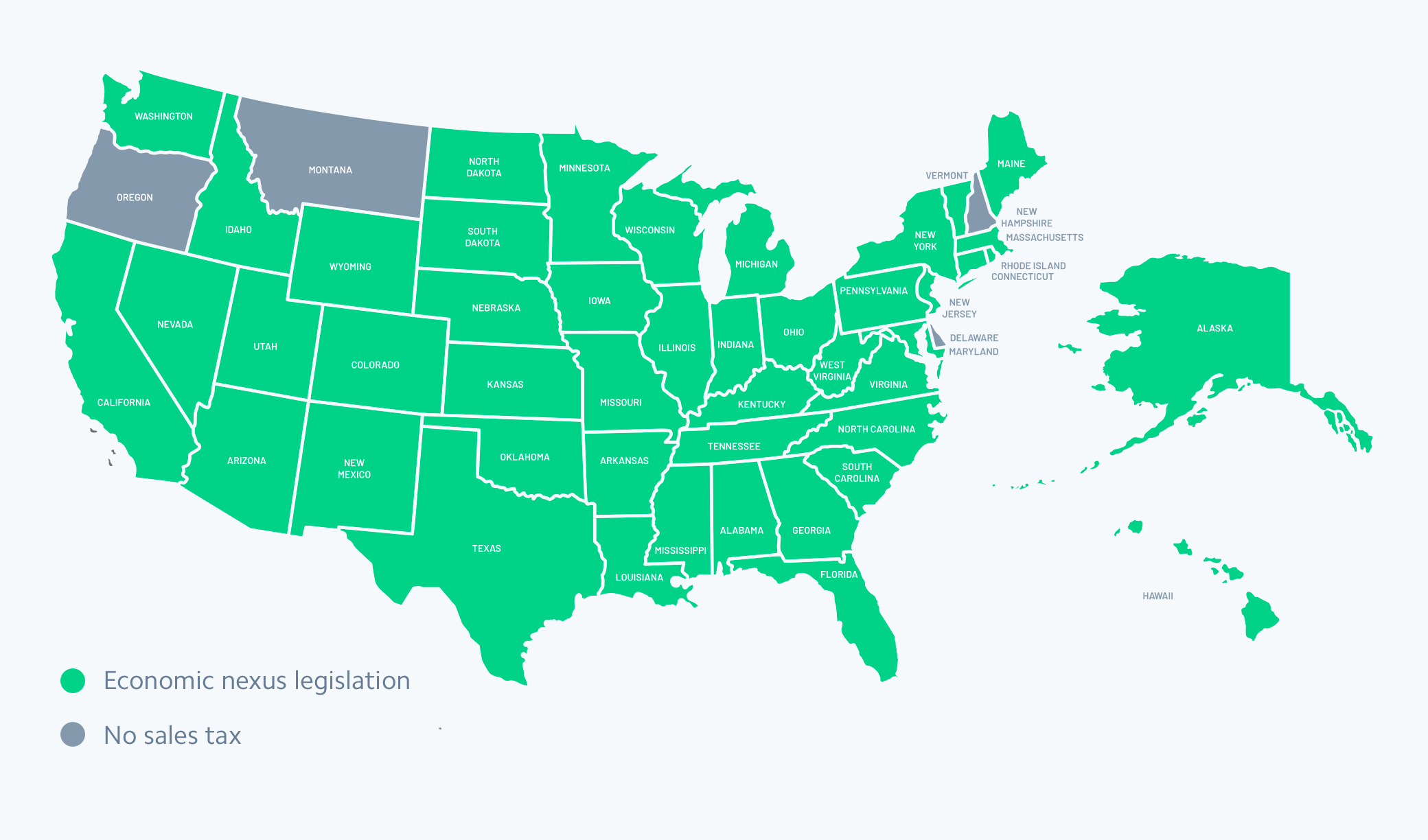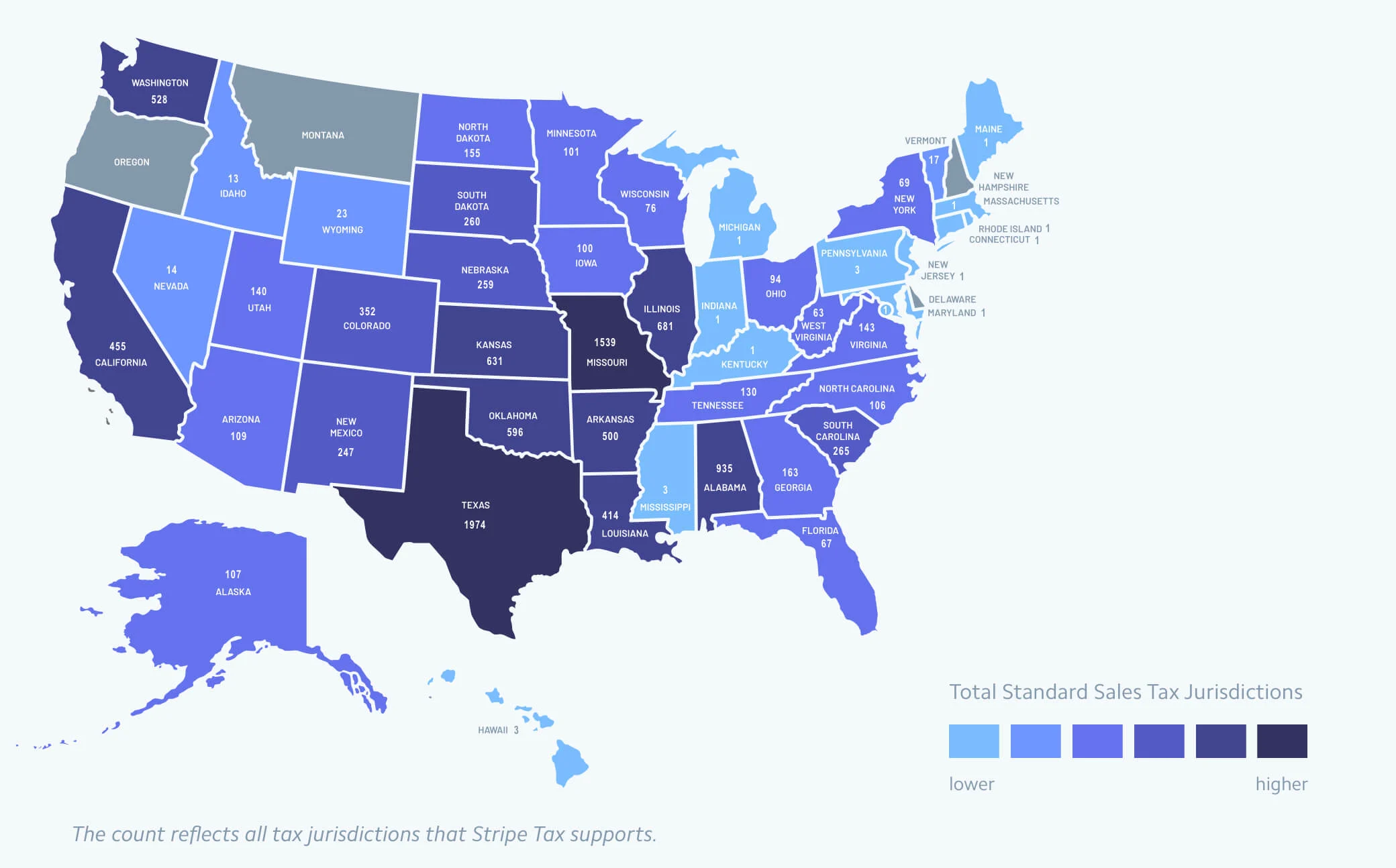Online businesses today are selling to customers in multiple US states and beyond. In fact, more than 80% of startups that use Stripe sell into over 20 states and countries. While it's easier than ever to reach customers online, selling in more places can lead to added complexity.
Sales tax is one example of this complexity: If your business sells to customers in the US, you need to comply with sales tax laws in the US states where you meet registration thresholds. These thresholds, tax rules, and the rates that apply vary by state and by product. The more products you sell and the more locations you sell into, the more difficult taxes become.
This guide is for businesses that sell to customers in the US and covers the basics of economic nexus. You'll learn how to identify where you have reached registration thresholds, how to determine the correct tax rate depending on what and where you sell, and how to file and remit your taxes. You'll also learn how Stripe Tax can help you comply.
For more information on tax when selling to European customers, see our Guide to EU VAT and VAT OSS.
What is economic nexus?
The term economic nexus refers to a business presence in a US state that makes an out-of-state seller liable to collect sales tax there once a set level of transactions or sales activity is met. In the US, sales tax is primarily regulated at the state level, and every state has different laws and rules. Before the rise of the internet, it was simple to determine whether you had economic nexus in a certain place. If you had a store, office, warehouse, employee, or temporary trade show in a particular state, you would need to collect sales tax there.
This worked until the advent of ecommerce. Once the internet economy gained traction, online retailers gained an advantage over local businesses because they effectively didn’t have to charge and remit sales tax. Plus, states missed out on a total of up to $33 billion of taxable income a year.
In 2018, the Supreme Court weighed in and set a new precedent in the South Dakota vs. Wayfair ruling. A state can now require a business to collect sales tax even if they don’t have a physical store or sales representative there. Since then, an “economic” presence, or reaching a set level of transactions or sales activities, is enough to trigger nexus status for that state. And of course, you are required to register in any state in which you have a physical presence.
What are the consequences of not complying with economic nexus laws?
Business owners need to understand their sales tax nexus and corresponding liability to avoid needing to pay uncollected taxes plus fines and interest. You are required to file taxes in all states where you are registered to collect taxes, even if you have no sales tax liability during that period.
If you should have collected sales tax from your customers but failed to, you’ll have to pay past-due sales tax out of your own pocket with interest and penalties that average 30% of the amount of sales tax due.
How to comply with sales tax rules and regulations
Complying with economic nexus is a multipart process that depends on the precise location of your business and your customers, your sales volume, and the products you sell. Here are the three key steps to adhering to tax laws in the US as a business:
1. Determine where you have nexus
There are 46 US states that have economic nexus laws. Meeting economic nexus status usually occurs after you've passed a specific transaction or revenue threshold. Most of these thresholds are based on the past 12 months of activity, with requirements and deadlines for registering with the state to pay tax that also vary.

This image shows which US states have economic nexus laws.
In most states, the threshold for economic nexus is $100,000 in sales or 200 transactions over 12 months. There are exceptions, though; for example, in Texas and California the threshold is $500,000.
What should businesses do if they meet the sales tax nexus threshold?
Once businesses meet the threshold for economic nexus in a local jurisdiction, they should register to collect taxes on the website for the state agency that is responsible for sales taxes. Businesses should not collect taxes if they have not yet registered with the applicable jurisdiction. There are differences in each state’s registration requirements. For example, in Texas, out-of-state businesses would need to register by the first day of the fourth month after they reach the economic nexus threshold. In Rhode Island, businesses have until January 1 of the year after they reach the economic nexus threshold to register, collect, and begin remitting sales tax.
The specific laws also vary depending on whether you’re selling physical products, digital products, or software as a service (SaaS) products. Digital products—such as e-books, online courses, music files, and website memberships—can be especially complex. Not all states tax digital goods. Jurisdictions that do tax these goods have their own definitions of what constitutes a digital product.
Although SaaS products count as digital products, they often have unique regulations because they're not necessarily downloaded. For example, SaaS sales are 100% taxable in Connecticut but non-taxable in California. And in Texas, SaaS products are taxed at 80% of the sale price, while downloaded software is fully taxed. See where SaaS is considered taxable here.
2. Check your jurisdiction and determine your tax rates
There are more than 11,000 tax jurisdictions in the US, all with different regulations. In Alabama alone, there are more than 900 tax jurisdictions, and Texas has more than 1,900. Unfortunately, states with fewer tax jurisdictions aren't necessarily less complicated because there can be enormous variation in administrative processes and enforcement. You need to research each state and jurisdiction individually to ensure you're filing correctly.
Tax rates vary depending on what you're selling and where, and they are constantly updated. More than 500 tax rate changes are expected to happen in 2024 in the US alone. Virginia, for example, is exempting some gun safes from sales tax, while the city of Chicago will begin taxing ecommerce sales of wine and bottled water.
Origin-based vs. destination-based sales tax rates
Once businesses meet the threshold for economic nexus, it’s important to understand the difference between origin-based and destination-based sales tax rates.
If your business is located in an origin-based state, you would charge the state and local sales tax rate for where your business is located.
For a destination-based state, you would calculate the sales tax rate for where your buyer is located (or where the items are being shipped to).
Twenty-four states are participating in the Streamlined Sales and Use Tax Agreement (SSUTA), a board that was established to help businesses manage their tax obligations across jurisdictions. However, since many states don't participate, it doesn't create a uniform system across states. You still need to pay close attention to each state's specific guidelines.
3. File and remit your taxes
Visit the website for each state's agency responsible for the administration of sales taxes for details on how to file, and perhaps more importantly, when to file. The deadlines will vary from state to state, and the frequency with which you file will also vary significantly based on your location and your tax liability.

In Tennessee, you file sales tax annually if your monthly tax liability is at or less than $200. But if your tax liability surpasses $200, you have to file monthly by the 20th of the following month. For example, you would file sales taxes by February 20 for January sales. In contrast, New York’s Department of Taxation and Finance assigns a filing frequency (monthly, quarterly, or annual) to each business selling in the state depending on their sales volume.
How Stripe can help
Stripe Tax reduces the complexity of tax compliance so you can focus on growing your business. It automatically calculates and collects sales tax, VAT, and goods and services tax (GST) on both physical and digital products and services in all US states and more than 30 countries. Stripe Tax is natively built into Stripe, so you can get started faster—no third-party integration or plug-ins are required.
As a sales tax automation tool, Stripe Tax can help you:
- Understand where to register and collect taxes: See where you need to collect taxes based on your Stripe transactions, and switch on tax collection in a new state or country in seconds. You can start collecting taxes by adding one line of code to your existing Stripe integration; or add tax collection to Stripe's no-code products, such as Invoicing, with the click of a button.
- Register to pay tax: Let Stripe manage your tax registrations in the US and benefit from a simplified process that prefills application details—saving you time and ensuring compliance with local regulations.
- Simplify filing and remitting: With our trusted global partners, users benefit from a seamless experience that connects to your Stripe transaction data—letting our partners manage your filings so you can focus on growing your business.